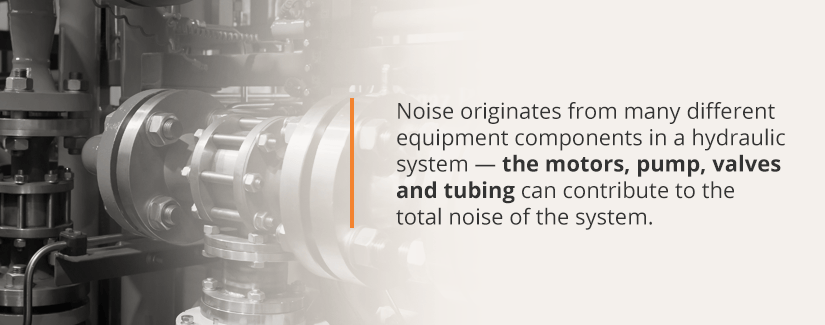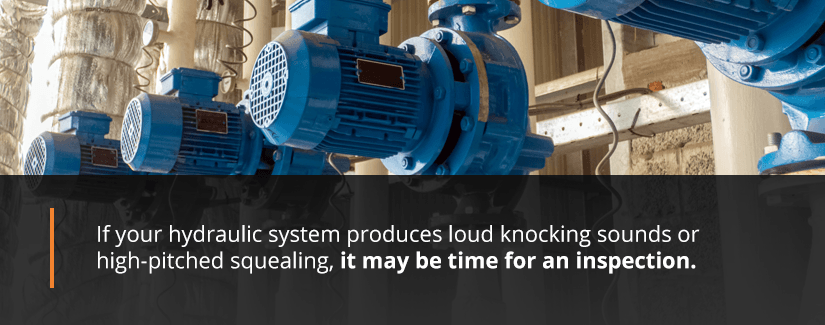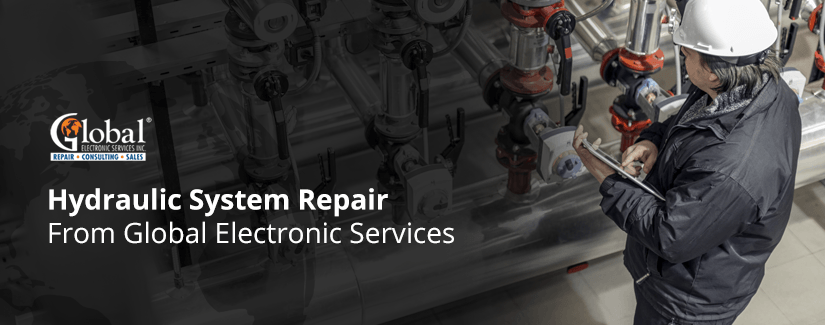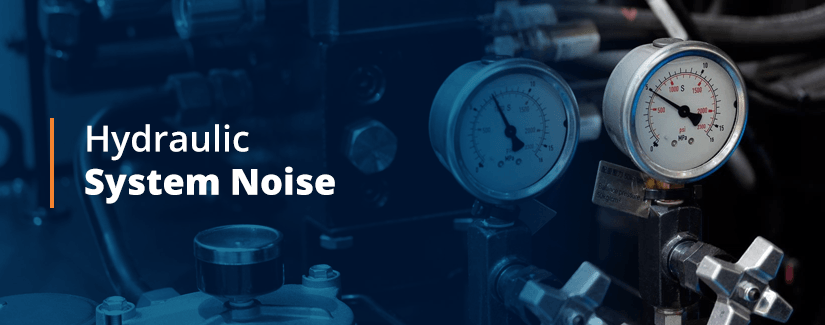Hydraulic systems have valuable applications in many machine solutions, however, they can also be extremely noisy. And, in industrial facilities with many machines running at the same time, noise can rise to a dangerous level. Hydraulic systems that are too loud can result in headaches, hearing damage and even total hearing loss caused by extended exposure. Excessive noise can also cause elevated stress, poor communication between workers and impaired focus which can lead to workplace accidents.
According to the Occupational Safety and Health Administration (OSHA), work environments expose 22 million workers to potentially damaging sound levels every year. These unsafe noise levels can be costly for both the health of workers and for the company — failure to protect workers from noise has cost companies over $1.5 million in penalties per OSHA’s most recent numbers.
Luckily, companies can use many strategies to reduce hydraulic system noise to avoid costly fines and keep their workers safe. Effective noise control begins with understanding the sources of noise in a hydraulic system and then implementing solutions to control and prevent noise. This article will describe the various sources of hydraulic system noise and offer guidance for reducing hydraulic system noise in your facility.
Areas of a Hydraulic System Where Noise Comes From

Noise originates from many different equipment components in a hydraulic system — the motors, pump, valves and tubing can contribute to the total noise of the system. Depending on where it comes from, noise travels through a hydraulic system in three distinct ways:
- Airborne noise: Noise that travels from an equipment component through the air is considered airborne noise. This noise originates from various moving equipment components, such as motors and fans, and is received by the ear as audible sound. All other types of noise must eventually become airborne noise to be heard by workers.
- Fluid-borne noise: Noise can also be transmitted through a hydraulic system by the hydraulic fluid. Fluid-borne noise is produced when pressure pulsations created by pumps or pistons create vibrations at the surface of the tube or hose. These vibrations are then transferred by the hose clamps to other adjacent components and the vibrations produce fluid-borne noise.
- Structure-borne noise: When vibration travels through the structure of the hydraulic system, rather than the fluid, it produces structure-borne noise. This type of noise originates in one component of the hydraulic system and is transferred to other parts until it is released as airborne noise.
Even when hydraulic systems are operating properly, noise is inevitable because of the movement and vibration of equipment components. Here are a few main sources of airborne, fluid-borne and structure-borne noise in hydraulic systems:
1. Electric Motor
The power unit in a hydraulic system is often the loudest system component. Many parts of the electric motor can produce noise in a hydraulic system. The bearings, rotor and stator assembly and fan are all common sources of airborne and structure-borne noise in the electric motor.
The fan in an electric motor is essential for cooling the system to prevent overheating but produces a significant amount of noise from its rotation. The movement of the fan and other motor components can also produce vibration in the bearings of the motor that produces structure-borne noise. The rotor and stator assembly are responsible for the characteristic hum of electric motors in hydraulic systems.
One simple way to reduce electric motor noise is to use a fan that rotates in only one direction. This lowers the amount of noise produced while still effectively cooling the equipment. Another strategy for quieter motor operation is to choose a 1200 RPM motor instead of the standard 1800 RPM motor. Although a 1200 RPM motor will be more expensive, larger and heavier, it will also significantly reduce noise levels due to its slower rotation.
2. Pump
The pump is another major source of noise in a hydraulic system and produces both structure-borne and fluid-borne noise. The movement of bearings, pistons and gears within the hydraulic pump produce vibrations that create structure-borne noise. This noise is easily transmitted through the metal housings of the pump to be released as airborne noise. When connected to an electric motor, hydraulic pumps produce even more noise.
Fluid-borne noise from hydraulic pumps is created by pressure ripples that are a result of the pump’s pulsating motion. The pressure ripples and uneven flow of the fluid cause fluid-borne excitation and produce noise from vibrations at the surface of hoses and tubing.
Several strategies are available to control hydraulic pump noise by altering the pump operation or design:
- Liquid submersion: To create a noise barrier, you may submerge the motor-pump assembly in oil or other liquid. By submerging the pump and motor in a liquid reservoir, sound waves are dampened, and less airborne noise is emitted.
- Lower speed operation: Running the pump at a lower speed can reduce the amount of noise produced. Using several smaller pumps instead of a single large pump can also reduce noise.
- Variable-speed pump design: A variable-speed pump will run at different speeds to match the duty-cycle. This can reduce the overall noise produced by the pump because pump speed is reduced when operation does not require a higher speed.
- Pre-compression chamber design: A pump design with a pre-compression chamber can help reduce flow pulsation to produce less vibration and less noise. When peaks in fluid flow are reduced through a pre-compression chamber, the total reduction in hydraulic system noise can be up to 5 dBA.
Liquid submersion is one of the most common ways to address hydraulic pump noise as it is an affordable way to reduce noise without implementing an entirely new pump design. However, when choosing a new hydraulic system, companies may seek a quieter pump design to create lower noise levels in their facility.
3. Hydraulic Motor and Cylinder

Hydraulic motors, cylinders and other actuators can produce a significant amount of noise from vibrations in the fluid and structure. These physical vibrations can travel through the structure of the equipment to be released as airborne noise. Hydraulic cylinder noise is often quieter than pump noise, however, because hydraulic motors typically operate at lower speeds.
Hydraulic cylinders can also produce a loud squealing sound when they are not operating correctly. Abnormal hydraulic cylinder noise typically indicates aeration in the hydraulic fluid caused by a leak somewhere in the hydraulic system. The aerated fluid is compressed during cylinder operation to produce a high-pitched whining sound that can travel through the equipment until it is released as airborne noise.
Because of noise transfer, it can be difficult to identify where the sound originated. But by inspecting the oil quality and the cylinder itself, hydraulic cylinder noise can be correctly identified and mitigated.
4. Tubing and Hoses
Fluid conductors in a hydraulic system can also produce noise through vibrations. Pressure pulsations and uneven flow through tubing and hoses can cause them to rattle and distribute noise over a large area within the system.
To reduce noise caused by fluid conductors, metal tubing should be designed with hose assemblies at each end of long sections of tubing. This isolates the noise within the tubing, reduces vibrations and prevents noise from traveling through the system. By combining rigid and flexible components in fluid conductors, less airborne noise is produced, and system operation is quieter. Tubing should also be secured using sturdy clamps that reduce rattling and banging noises.
5. Valves
Valves in a hydraulic system do not typically produce very much noise except when they are not working properly. If valves are not operating correctly or have leaks, air may enter the hydraulic system or vapor cavities can be created. When these pockets of air or vapor are compressed they can produce a loud bang. Poppet valves can also produce noise, such as buzzing or whining if the do not seat properly.
Noise produced by valves in hydraulic systems can be reduced by better valve design or by adding cushioning features to valves. Correct hydraulic valve packing is also essential to help prevent leaks and ensure consistent valve operation. Regularly inspecting hydraulic valves to ensure they are operating properly can also prevent leaks that lead to noisy operation of hydraulic systems.
Other Problematic Causes of Hydraulic System Noise

Aside from regular operational noise, abnormal noises are often a sign of problems within a hydraulic system. If your hydraulic system produces loud knocking sounds or high-pitched squealing, it may be time for an inspection. Here are a few common causes of abnormal hydraulic system noise:
1. Aeration
Aeration is a common cause of abnormal noises in a hydraulic system. Aeration occurs when air enters the hydraulic system through the pump intake lines or shaft seal. Low fluid levels in the reservoir can also create a vortex that pushes air into the hydraulic system through the pump intake. As air flows through the system in the hydraulic fluid, the air compresses and decompresses, producing loud knocking or banging sounds.
Aeration may also cause whining or shrieking noises to come from the hydraulic cylinder. When air bubbles in the fluid enter the hydraulic cylinder, they are compressed by the motion of the cylinder. This causes the oil to heat up and release energy as a loud squealing sound. A reliable indication of aeration in the fluid is when the oil appears foamy.
Aeration in a hydraulic system can cause fluid degradation and loss of lubrication of equipment components. This can cause damage to the equipment through overheating, excessive friction and burning of seals. Aeration can even cause pump failure if it is not addressed. Proper equipment maintenance can protect against damaging aeration by catching the problem before it becomes too serious.
When inspecting a hydraulic pump, check for any leaks in the pump intake lines and shaft seal. Replace any intake lines that are old or worn to prevent air from leaking into the system. If your hydraulic pump is making a whining noise, inspect the oil to see if it is foamy — a telltale sign of aeration.
The fluid level in the reservoir should also be checked regularly and refilled to the correct level if it is low. Another effective method for eliminating air bubbles from the fluid in the reservoir is to install a fine-mesh screen. Placing a screen at a 30-degree angle in the fluid reservoir can remove up to 90 percent of entrapped air.
2. Cavitation
Another possible cause of knocking or banging noises in a hydraulic system is cavitation. If the volume of fluid flowing through a part of the hydraulic system is lower than the volume required by that part, it can cause vapor cavities to form. These cavities form when the absolute pressure inside the part drops lower than the pressure of the fluid itself. As these cavities collapse under pressurization in the system, they produce a banging sound.
Cavitation often occurs at the hydraulic pump but can happen in any part of the hydraulic system. If intake lines or filters are clogged or blocked, this reduces the volume of fluid flowing through the system which can lead to cavitation.
Cavitation can be damaging to a hydraulic system as it may cause metal erosion and fluid contamination. The contamination of fluid can damage equipment components or even lead to equipment failure.
When inspecting your hydraulic system, check intake lines and filters for blockage to prevent cavitation. Also inspect valves to ensure they are opening fully to allow enough fluid to flow through the hydraulic system. By paying attention to the noise produced by your hydraulic system, you can catch and correct problems before they lead to system failure.
How to Control and Prevent Noise in a Hydraulic System

When not controlled, hydraulic system noise can create a hazardous and uncomfortable workplace. When workers are unable to communicate clearly in a loud environment, this can lead to potentially fatal accidents. Long-term exposure to high noise levels can also cause hearing damage or loss.
Companies must also comply with OSHA regulations for permissible noise levels to avoid fines. For an eight hour shift, workers may only be exposed to 90 dBA of noise. Even short term noise exposure of 15 minutes or less must be limited to 115 dBA or lower. For facilities using noisy hydraulic systems, this means measures must be taken to produce quieter system operation. Here are a few steps for reducing hydraulic system noise:
- Use vibration-damping mounts: Vibration-dampening mounts are a simple and effective tool for reducing hydraulic system noise by reducing vibrations of equipment components. These mounts can be used when mounting the motor-pump assembly to the subframe as well as when mounting the subframe to the power unit.
- Install a noise barrier: Another affordable method for reducing noise levels in your facility is to install noise barriers between hydraulic systems and workers. Noise barriers may be boxlike enclosures or sound-dampening materials wrapped around the hydraulic system. Using thicker plates for the hydraulic reservoir can also serve as an additional barrier to reduce the amount of airborne noise emitted from the hydraulic system.
- Lubricate moving parts: When moving parts are properly lubricated, they will operate more quietly and produce fewer vibrations. Keeping your equipment well-lubricated can also increase the lifespan of your hydraulic system.
- Contact the manufacturer: If your company is unable to reduce hydraulic system noise through these steps, consider contacting the manufacturer. Equipment manufacturers can provide valuable insights into how to best control noise from various components of their hydraulic system.
- Contact an engineering service lab: A laboratory that specializes in designing and testing hydraulic systems may be able to provide additional solutions for effective noise control. Engineering service labs may have experts in hydraulic systems who can suggest design modifications to reduce noise.
- Consider repairs: If your hydraulic system is producing abnormal or unusually loud sounds — such as squealing, whining, banging or knocking — there may be an underlying problem causing the noise. Noise coupled with other operational issues may also point to a leak, blockage or other functional issue. Contact a professional to take a look at your system to identify and fix the problem before a breakdown occurs.
By paying attention to the noise produced by your hydraulic system, you can catch problems early and keep your system in peak running condition. And by taking steps to reduce regular operational noise levels, you can keep your workers safe and your facility running smoothly.
Hydraulic System Repair From Global Electronic Services

With effective noise control, you can keep your hydraulic system running more quietly to improve the safety and productivity of your facility. Noise control also makes it easier to notice abnormal noises that may indicate a problem with your hydraulic system. If you are concerned by the noise of your hydraulic system or are in need of hydraulics repair, contact Global Electronic Services for a professional inspection and efficient repair. To request a quote for hydraulics repair, call 877-249-1701 or contact Global Electronic Services online today.
